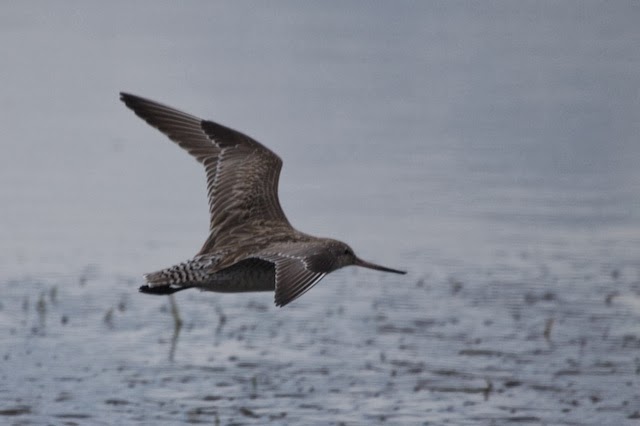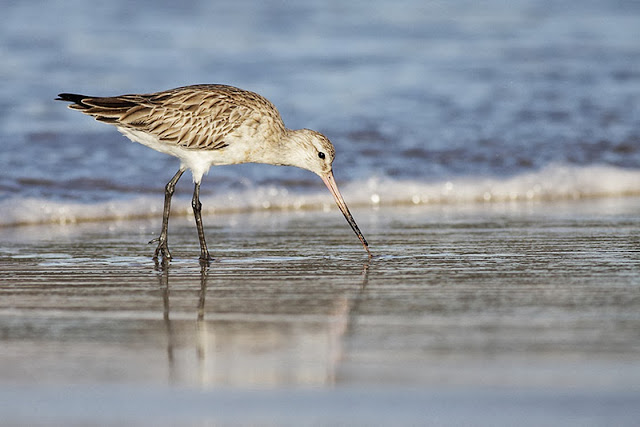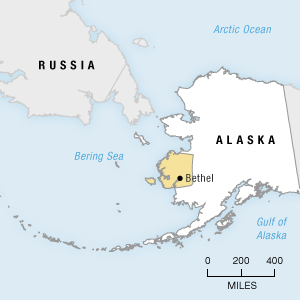Alaska Bird Makes Longest Nonstop Flight Ever Measured
Dave Hansford in Wellington, New Zealand
for National Geographic News
September 14, 2007
It's the longest nonstop bird migration ever measured, according to biologists who tracked the flight using satellite tags.
The bird, a wader called a bar-tailed godwit, completed the journey in nine days.
In addition to demonstrating the bird's surprising endurance, the trek confirms that godwits make the southbound trip of their annual migration directly across the vast Pacific rather than along the East Asian coast, scientists said.
"This shows how incredible and extreme birds can be," said Phil Battley of New Zealand's Massey University, who took part in the study.
"The prospect of a bird flying all the way across the Pacific was so much further than what we thought possible, it seemed ludicrous," he said.
"Like Running for a Week"
The long haul was documented during a study of godwit migration conducted by the U.S. Geological Survey and PRBO Conservation Science, a California-based nonprofit dedicated to bird research.
Some 70,000 godwits make the epic journey from their northern summer breeding grounds in Alaska down to New Zealand each September, before flying all the way back the following March.
To study this annual trek north, Battley and his colleagues fitted satellite transmitters to 16 godwits at two locations in New Zealand last summer.
Battley was amazed, he said, to find that one of the birds, dubbed E7, flew some 6,340 miles (10,200 kilometers) directly to a wetland on the North Korea-China border (see map).
After feeding and resting there, she continued another 3,000 miles (5,000 kilometers) to Alaska.
The flock's arrival in the U.S. was supposed to mark the end the study, but some of the tags' transmitters continued to send data, giving scientists the unexpected bonus of tracking the birds' return trip.
Scientists found that, on E7's way back south, with the help of tailwinds, she made the epic 7,145-mile (11,500-kilometer) flight to New Zealand uninterrupted.
"This organism is absolutely outstanding," said Rob Schuckard, a team leader at the Ornithological Society of New Zealand, which helped with the migration research.
"It's the equivalent of a human running at 70 kilometers an hour [43.5 miles an hour] for more then seven days."
According to satellite data, E7 flew at an average speed of 34.8 miles an hour (56 kilometers an hour), seeking favorable winds at elevations between 1.85 miles (3 kilometers) and 2.5 miles (4 kilometers).
Along the way, the bird "slept" by shutting down one side of her brain at a time and burned up the huge stores of fat—more than 50 percent of her body weight—that she had piled on in Alaska.
E7 found her way by analyzing polarized light to get a fix on the sun by day, even in heavy clouds, and by following the stars at night, Battley said.
"They learn the rotation of the sky when they're young," he explained.
"They can work out where north is, but presumably they have to learn a Southern Hemisphere compass as well. It's no good looking for the North Star in New Zealand."
An Uncertain Future
Despite the birds' hearty endurance, Schuckard fears for the godwits. The number of birds successfully reaching New Zealand each year has fallen sharply, he said, from around 155,000 in the mid-1990s to just 70,000 today.
"Something is seriously wrong," he said.
He suspects that widespread development along the Yellow Sea, which sits between China and North and South Korea, is depriving the birds of vital food sources, as mudflats and wetlands there are drained.
At one such site, the Saemangeum wetlands of South Korea, recognized as a crucial staging site for waders, a 20.5-mile (33-kilometer) seawall built last year has drained 154 square miles (400 square kilometres) of tidal flats.
"That's equal to the entire New Zealand estuarine habitat [where rivers meet the sea]," Schuckard said.
Battley agreed that godwits and other migrating waders face serious threats, as their feeding and resting grounds dwindle.
"Loss of habitat on the staging grounds is a real concern," he said. "The Yellow Sea is a particular problem, because virtually every godwit from New Zealand will go through there. If you look at South Korea, it's full of seawalls—they reclaim entire estuaries at a go."
Some mudflat loss has been offset by increased sediment loads dumped by China's Yellow and Yangtze rivers, he added.
"[But] the problem now is that with all the dams on those rivers, the Yellow River is running dry half the year, and the Three Gorges Dam is trapping most of the sediment that came down the Yangtze," Battley said.
"Shorebird migrants, through the Yellow Sea at least, have a very tough time coming up [north]," he said.
The Toughest Little Bird You've Never Heard Of
by ROBERT KRULWICH
September 21, 201110:05 AM
A Bar-tailed Godwit in Australia
Leo Berzins via Flickr
They are the only birds known to fly more than 7,000 miles nonstop, that means no food breaks, no water breaks, no sleep breaks, no pausing, just pushing through cyclones, storms, headwinds, flappity flap, flap for days and nights — and this is their championship season. In September and October, they leave Alaska, head straight for the ocean. Though they are land birds, and cannot fish or rest on the sea, they will cross most of the Pacific Ocean, and fly all the way to New Zealand. Many of them are young, and have never done this before. No other bird can do what they do, and they're doing it right now.
Map of the southward Bar-tailed Godwit migration, from a study published by Proceedings of the Royal Society B, 2009.
Robert E. Gill, et al/USGS/The Royal Society
Then they wait. What they want is a good wind to help them south. This time of year, at the Yukon-Kuskokwim Delta in Alaska, the weather often obliges.
Map of the Yukon-Kuskokwim Delta
Source: NPR
Credit: Stephanie d'Otreppe
Fighting The Winds
Black-tailed Godwits flying.
Gidzy via Flickr
How they do that, many of them never having been in the southern hemisphere, never having seen the southern stars, nobody seems to know. But they manage. One female, dubbed E7, because that was the code on her wireless transmitter, is the current world champion: she flew 11,680 kilometers (7,369 miles) in 8.1 days. Non-stop. (Gill knows that because the transmitter told him so.)
Bar-tailed and Black-tailed Godwit in flight
Marj Kibby via Flickr
Nobody Does It Better
What a bird! There are 70,000 of them, but they seem to be losing population. The trek back north in the spring takes them west, to Asia, where they stop and feed. Wetlands are being drained in that part of the world, which may make it hard for them to make the last leg home to Alaska. It would be a terrible thing to have these fierce, athletic birds wink out.
So while they're with us, performing their unmatched Kuaka feats of flight, I think it's only right that we go to bat for them, pr-wise, get them a show on Bravo ("The Real Kuakas of New Zealand"), get them booked on Leno and Letterman, get Mario Batali to reproduce their miracle diet, and — why not? — reach out to other birds who might want to know a little more about the "Kuaka lifestyle."
I asked my friend Josh Kurz to work on a few ideas — he has dabbled in advertising — and he came up with an ad that celebrates these birds so much, you're going to have to click on it two times to read it all. It's aimed, strangely, at owls and turkeys — who don't share the Kuaka's migratory urge, but hey, Josh is just publicizing what the rest of us — human, bird, whatever — really ought to know: that these birds may look puny, but under those plain brown feathers lies a mighty heart.







No comments:
Post a Comment